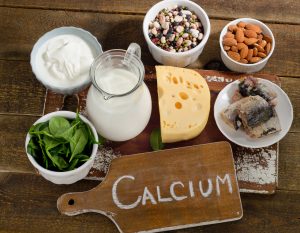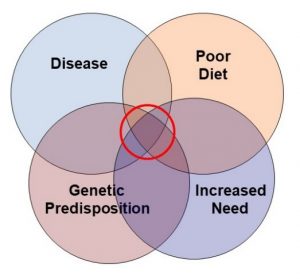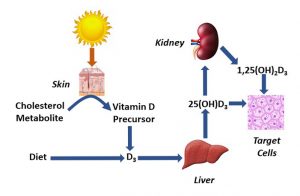How Can We Improve Nutrition In Disadvantaged Communities?
 Recently there has been increased focus on health disparities in disadvantaged communities. In our discussions of the cause of these health disparities, two questions seem to be ignored.
Recently there has been increased focus on health disparities in disadvantaged communities. In our discussions of the cause of these health disparities, two questions seem to be ignored.
1. Does poverty play a role in poor nutrition?
2. Does poor nutrition play a role in the health disparities we see in disadvantaged communities?
The study (K Marshall et al, PLoS One 15(7):e0235042) I discuss in this week’s “Health Tips From The Professor” attempts to address both of these questions.
Before, I start, let me put this study into context.
- Osteoporosis is a major health problem in this country. Over 2 million osteoporosis-related fractures occur each year, and they cost our health care system over 19 billion dollars a year. Even worse, for many Americans these osteoporosis-related fractures often cause:
-
- A permanent reduction in quality of life.
-
- Immobility, which can lead to premature death.
- Inadequate calcium and vitamin D intakes increase the risk of osteoporosis.
While most studies simply report calcium and vitamin D intakes for the general population, this study breaks them down according to ethnicity and income levels. The results were revealing.
How Was The Study Done?
 This study drew on data from the 2007-2010 and 2013-2014 National Health and Nutrition Examination Surveys (NHANES). These surveys are conducted by the National Center for Health Statistics, which is part of the CDC. They are designed to assess the health and nutritional status of adults and children in the United States and are used to produce health statistics for the nation.
This study drew on data from the 2007-2010 and 2013-2014 National Health and Nutrition Examination Surveys (NHANES). These surveys are conducted by the National Center for Health Statistics, which is part of the CDC. They are designed to assess the health and nutritional status of adults and children in the United States and are used to produce health statistics for the nation.
The NHANES interview includes demographic, socioeconomic, dietary, and health-related questions. The examination component consists of medical, dental, and physiological measurements, as well as laboratory tests administered by highly trained medical personnel. All participants visit a physician. Dietary interviews and body measurements are included for everyone.
This study measured calcium intake, vitamin D intake, and osteoporosis for adults 50 and older. The data were separated by gender, ethnic group and income level. Four different measures of poverty were used. For purposes of simplicity, I will only use one of them, income beneath $20,000, for this article.
Does Poverty Affect Nutritional Status?
The Effect of Ethnicity And Gender On Calcium And Vitamin D Intake:
 When the authors looked at the effect of ethnicity and gender on calcium and vitamin D intake, in people aged 50 and older the results were (Note: I am using the same ethnic nomenclature used in the article):
When the authors looked at the effect of ethnicity and gender on calcium and vitamin D intake, in people aged 50 and older the results were (Note: I am using the same ethnic nomenclature used in the article):
Hispanics:
-
- 66% (75% for women and 56% for men) were getting inadequate calcium intake.
-
- 47% (47% for women and 47% for men) were getting inadequate vitamin D intake.
Non-Hispanic Blacks:
-
- 75% (83% for women and 64% for men) were getting inadequate calcium intake.
-
- 53% (51% for women and 54% for men) were getting inadequate vitamin D intake.
Non-Hispanic Whites:
-
- 60% (64% for women and 49% for men) were getting inadequate calcium intake.
-
- 33% (30% for women and 37% for men) were getting inadequate vitamin D intake.
For simplicity, we can generalize these data by saying:
Gender:
-
- Women are more likely to be calcium-deficient than men.
-
- Men are more likely to be vitamin D-deficient than women.
Ethnicity: For both genders and for both calcium and vitamin D:
-
- The rank order for deficiency is Non-Hispanic Blacks > Hispanics > Non-Hispanic Whites.
The Effect Of Poverty On Calcium Intake, Vitamin D Intake, And Osteoporosis:
 When looking at the effect of poverty, the authors asked to what extent poverty (defined as income below $20,000/year) increased the risk of calcium and vitamin D deficiency in adults over 50. Here is a summary of the data
When looking at the effect of poverty, the authors asked to what extent poverty (defined as income below $20,000/year) increased the risk of calcium and vitamin D deficiency in adults over 50. Here is a summary of the data
Hispanics:
-
- For both Hispanic women and Hispanic men, poverty had little effect on the risk of calcium and vitamin D deficiency.
Non-Hispanic Blacks:
-
- For Non-Hispanic Black women, poverty had little effect on the risk of calcium deficiency, and vitamin D deficiency.
-
- For Non-Hispanic Black men, poverty increased the risk of both calcium and vitamin D deficiency by 32%.
Non-Hispanic Whites:
-
- For Non-Hispanic White women, poverty had little effect on the risk of calcium deficiency but increased the risk of vitamin D deficiency by 30%.
-
- For Non-Hispanic White men, poverty increased the risk of both calcium deficiency and vitamin D deficiency by 18%.
For simplicity, we can generalize these data by saying:
-
- Poverty increased the risk of both calcium and vitamin D deficiency for Non-Hispanic Black men, Non-Hispanic White women, and Non-Hispanic White men.
Other statistics of interest:
- The SNAP program (formerly known as Food Stamps) had little effect on calcium and vitamin D intake. There are probably two reasons for this:
-
- In the words of the authors, “While the SNAP program has been shown to decrease levels of food insecurity, the quality of the food consumed by SNAP participants does not meet the standards for a healthy diet.” In other words, the SNAP program ensures that participants have enough to eat, but SNAP participants are just as likely to prefer junk and convenience foods as the rest of the American population. The SNAP program provides no incentive to eat healthy foods.
-
- We also need to remember that dairy foods are a major source of calcium and vitamin D in the American diet and that Hispanics and Non-Hispanic Blacks are more likely to be lactose-intolerant than the rest of the American population. There are other sources of calcium and vitamin D in the American diet. But without some nutrition education, most Americans are unaware of what they are.
- An increased risk of osteoporosis was found in Non-Hispanic Black men, and Non-Hispanic Whites with incomes below $20,000/year.
-
- This increased risk of osteoporosis was seen primarily for the individuals in each group who were deficient in calcium and vitamin D. There were other factors involved, but I will focus primarily on the effect of poverty on calcium and vitamin D intake in the discussion below.
How Can We Improve Nutrition In Disadvantaged Communities?
 Let’s start with the two questions I posed at the beginning of this article:
Let’s start with the two questions I posed at the beginning of this article:
1. Does poverty play a role in poor nutrition?
2. Does poor nutrition play a role in the health disparities we see in disadvantaged communities?
In terms of calcium intake, vitamin D intake, and the risk of osteoporosis, the answer to both questions appears to be, “Yes”. So, the question becomes, “What can we do?”
It is when we start to ask what we can do to increase calcium and vitamin D intake and decreased the risk of osteoporosis in disadvantaged communities that we realize the complexity of the problem. There are no easy answers. Let’s look at some of the possibilities.
[Note: I am focusing on what we can do to prevent osteoporosis, not to detect or treat osteoporosis. The solutions for those issues would be slightly different.]
1. We could increase funding for SNAP. That would increase the quantity of food available for low income families, but, as noted above, would do little to improve the quality of the food eaten.
2. We could improve access to health care in disadvantaged communities. But unless physicians started asking their patients what they eat and start recommending a calcium and vitamin D supplement when appropriate, this would also have little impact on diet quality.
3. We could improve nutrition education. A colleague of mine in the UNC School of Public Health ran a successful program of nutrition education through churches and community centers in disadvantaged communities for many years. The program taught people how to eat healthy on a limited budget. Her program improved the health of many people in disadvantaged communities.
However, the program was funded through grants. When she retired, federal and state money to support the program eventually dried up. The program she started is a model for what we should be doing.
4. The authors suggested food fortification as a solution. In essence, they were suggesting that junk and convenience foods be fortified with calcium and vitamin D. That might help, but I don’t think it is a good idea.
If we want to improve the overall health of disadvantaged communities, we need to find ways to replace junk and convenience foods with healthier foods. Adding a few extra nutrients to unhealthy foods does not make them healthy.
5. The authors also said that a calcium and vitamin D supplement would be a cheap and convenient way to eliminate calcium and vitamin D deficiencies. Unfortunately, supplements are currently not included in the SNAP program. Unless that is changed, even inexpensive supplements are a difficult choice for families below the poverty line.
As I said at the beginning of this section, there are no easy answers. It is easy to identify the problem. It would be easy to throw money at the problem. But finding workable solutions that could make a real difference are hard to identify.
Yes, we should make sure every American has enough to eat. Yes, we should make sure every American has access to health care. But, if we really want to improve the health of our disadvantaged communities, we also need to:
- Change the focus of our health care system from treatment of disease to prevention of disease.
- Train doctors to ask their patients what they eat and to instruct their patients how simple changes in diet could dramatically improve their health.
- Provide basic nutrition education to disadvantaged communities at places where they gather, like churches and community centers. This would cover topics like eating healthy, shopping healthy on a limited budget, and cooking healthy.
We don’t necessarily need another massive federal program. But those of us with the knowledge could each volunteer to share that knowledge in disadvantaged communities.
- Cover basic supplements, like multivitamins, calcium and vitamin D supplements, and omega-3 supplements in food assistance programs like SNAP.
The Bottom Line
Osteoporosis is a major health problem in this country. Over 2 million osteoporosis-related fractures occur each year, and they cost our health care system over 19 billion dollars a year. Even worse, for many Americans these osteoporosis-related fractures often cause:
- A permanent reduction in quality of life.
- Immobility, which can lead to premature death.
We know that inadequate calcium and vitamin D intakes increase the risk of osteoporosis. But most studies simply report calcium and vitamin D intakes for the general population. At the beginning of this article, I posed two questions.
- Does poverty play a role in poor nutrition?
2. Does poor nutrition play a role in the health disparities we see in disadvantaged communities?
A recent study looked at the effect of gender, ethnicity and income levels on calcium intake, vitamin D intake, and the risk of developing osteoporosis. The results of this study shed some light on those two questions.
When looking at the effect of gender and ethnicity on the risk of inadequate calcium and vitamin D intake, the study found:
- Women are more likely to be calcium-deficient than men.
- Men are more likely to be vitamin D-deficient than women.
- For both genders and for both calcium and vitamin D, the rank order for deficiency is Non-Hispanic Blacks > Hispanics > Non-Hispanic Whites. [Note: Note: I am using the same ethnic nomenclature used in the study.]
- Poverty (defined as incomes below $25,000/year) significantly increased the risk of both calcium and vitamin D deficiency for Non-Hispanic Black men, Non-Hispanic White women, and Non-Hispanic White men.
- An increased risk of osteoporosis was also found in Non-Hispanic Black men, and Non-Hispanic White men and women with incomes below $20,000/year.
- This increased risk of osteoporosis was seen primarily for the individuals in each group who were deficient in calcium and vitamin D.
In short, this study suggests that the answer to both questions I posed at the beginning of the article is, “Yes”.
For more information and a discussion of what we could do to correct this health disparity in disadvantaged communities, read the article above.
These statements have not been evaluated by the Food and Drug Administration. This information is not intended to diagnose, treat, cure, or prevent any disease.









